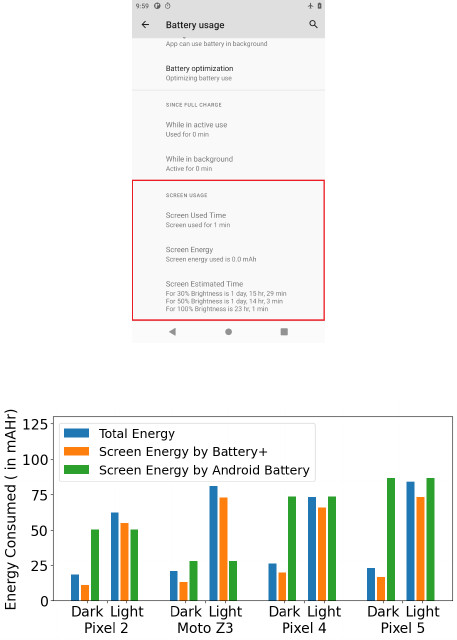
- A new study has found that dark mode doesn’t give you major efficiency gains in some scenarios.
- Researchers found that switching to dark mode from low to mid brightness only yielded between 3 to 9% savings.
- You see more energy gains by going from a light mode at maximum brightness to a dark mode, according to the study
Dark mode has been touted as one of the better features on phones today, allowing devices with OLED screens to save power compared to using a typical light mode. This is because OLED displays can turn off individual pixels to display black colors, saving juice in the process.
However, a new study by Purdue University researchers has shown that switching to dark mode might not make a big difference for power consumption with typical usage.
The researchers looked at six apps — namely Calculator, Google Calendar, Google Maps, Google News, Google Phone, and YouTube — using its newly developed tool called a Per-Frame OLED Power Profiler (PFOP). The team then looked at how dark mode affected a minute of activity for each app on the Pixel 2, Pixel 4, Pixel 5, and Moto Z3.
Related: Love dark mode? Here’s why you might want to avoid it
The result? Well, the team found that many consumers use auto-brightness settings that keep brightness at around “30-40%” when indoors. But the researchers said that switching from light mode at 30-50% brightness to dark mode only saves between 3 and 9% of power on average for all the tested devices.
However, the study found that users would see more significant power savings if they went from a light mode at high brightness to the dark mode. In fact, it noted that switching from a light mode with 100% brightness (as you might expect when outdoors in the sun) to dark mode could save 39 to 47% juice. That’s a major gain and could result in more than just a couple of extra minutes of power.
The study also claimed that Android’s battery consumption functionality doesn’t take dark mode into account when calculating an app’s power draw. The team says it’s developed a tool, dubbed Android Battery+, which takes dark mode into account. Purdue’s researchers say they plan to open-source the PFOP tool and add the Android Battery+ feature into the Android Open Source Project. The Battery+ functionality is highlighted in the red box in the picture below.

Some of these results do seem like a no-brainer though, as we already know that drastically high brightness in light mode can chew through a phone’s battery. So it stands to reason that you’d see higher gains switching from a light mode at super-duper high brightness to a dark mode than switching from a light mode at moderate brightness. Google even illustrated the relationship between dark mode and brightness with its own research back in 2018.
But what is interesting is just how little difference dark mode can make if you prefer low to mid brightness anyway. Therefore, those who don’t crank their phone brightness up in the first place might not want to switch to dark mode if they’re hoping for major energy gains.
We’d also be keen to see this test conducted using the same brightness measurement for each device (based on nits), as some phones have brighter screens than others. So 100% brightness on one phone might not be as bright as 100% brightness on another.
No comments:
Post a Comment